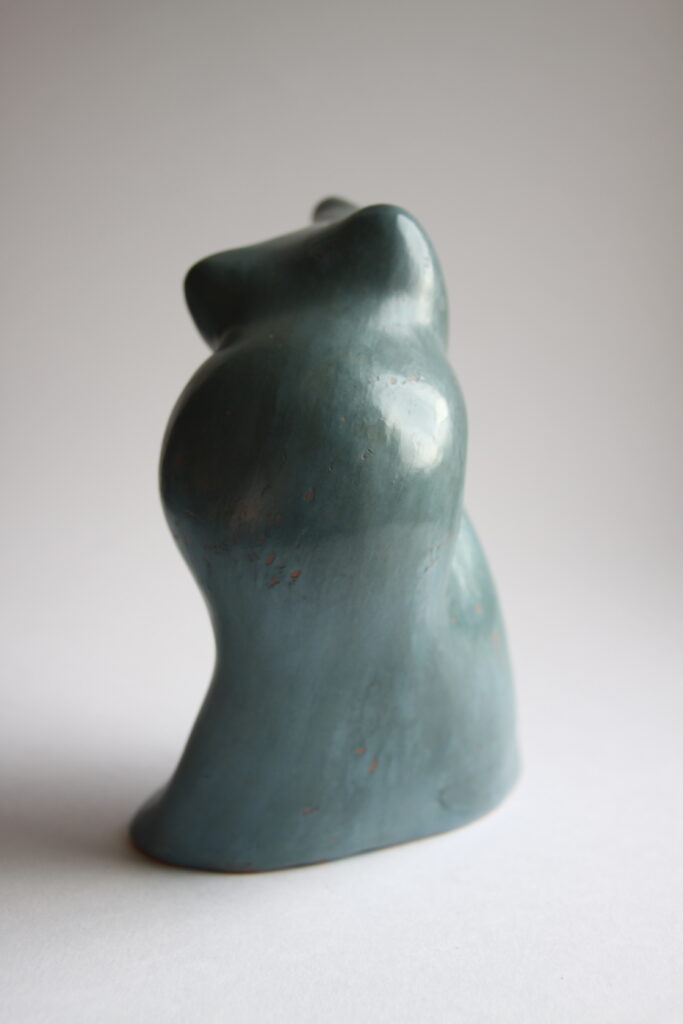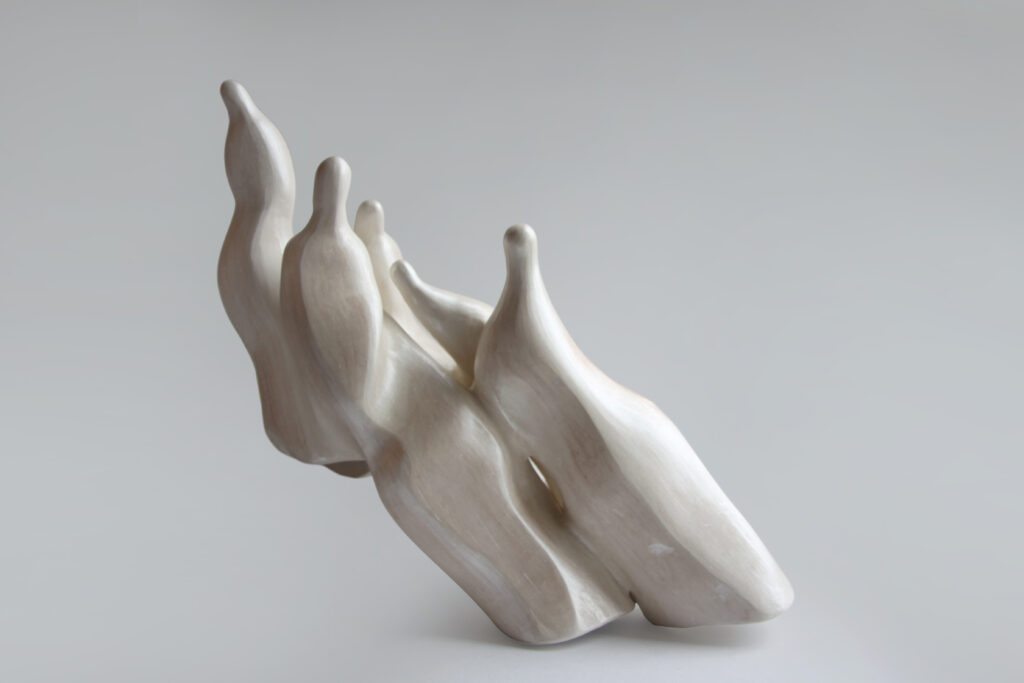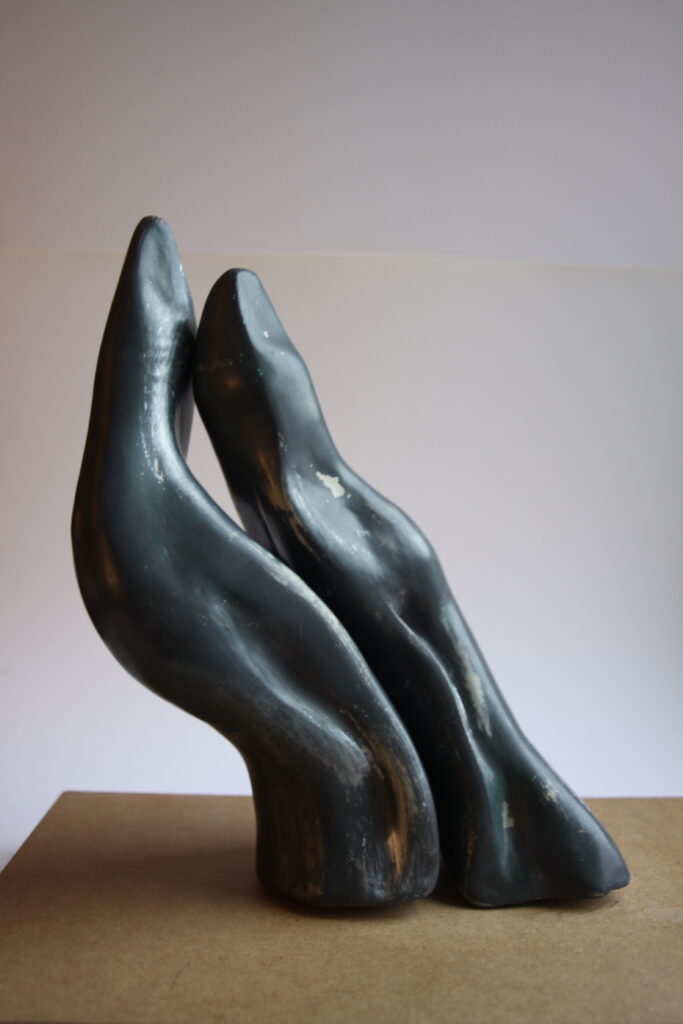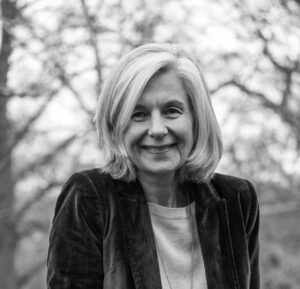First and foremost, I was guided by my passion for the material. Getting in touch with clay, working out shapes in line with my feelings and without models, without figurative or thematic research. A desire, like a course, then a search for lines.
“Often, a detail of one of my sculptures, a curve, a contrast, seduces me and becomes the seed of a new sculpture. I accentuate this curve, this contrast, and new forms are born… It often takes me months, even years, to bring a sculpture to fruition.” Jean Arp

At the heart of the creative process
I’m often asked if I have an idea at the outset. It’s a really interesting question, and one that leads to an answer about the heart of my approach: the one that was passed on to me and that drives me today. I would distinguish between large and small pieces.
Small sculptures...big emotions
In the case of the smaller pieces, especially the ones that touch me the most, something just clicked, very quickly.
I’ll always remember this tiny piece that emerged from my hands in one session, this pregnant woman who appeared all of a sudden, without any premeditation, and when I didn’t yet have a child, and I didn’t even imagine experiencing motherhood one day.
I remember the emotion I felt in front of this shape that sprang from my hands, and who knows, from me? Today, this sculpture is La Rayonnante. With its prehistoric figurine look, it conveys an indescribable joy, a state of being, so present that it commands the respect of those who look at it. I’ve been lucky enough to experience 3 pregnancies in this plenitude, this feeling of total existence. I like to think that my hands had this message for me.
Then there was Confiance, Tranquille Attente, each of which in its own way expresses how I felt at the end of pregnancy, in that seemingly endless and uncertain moment just before the birth of a child.
I’ve also met people who have been moved by La Rayonnante’s radiant, liberated shape, which has nothing to do with motherhood, being “round”, even strong, and radiant.
There were also small pieces that conveyed a different energy:
this double-sided piece, which for me, at the time, expressed a woman experiencing openness and liberation, and without my realizing it, the other side expresses great sadness, great tension. This sculpture became Tension.
At the time, I thought I’d freed myself from a lot of limits, and this sculpture reminded me that it was only a stage, that there were still many more to come.
These sculptures started out as pieces “on the solid”, which I then hollowed out. Each time, my hands had a message, and the whole point was to leave room for its expression, and to welcome it.

Genesis of the large-format sculptures

For large rooms, it’s a different story!
Monique Sidelsky talks a lot about this “empty space” approach, because it was at the heart of her pedagogy.
For these large-scale pieces, I often didn’t have a precise project at the outset. Or I did have an intention: I thought “family”, “couple”, “blossoming”, “round”.
The approach was to start with a dove. Then I decided how I wanted to start: one pillar, two pillars…
and then, once the work was sufficiently advanced, I began to give it shape, lines and movement.
It’s still in its infancy, but it’s already taking shape.
And then, as the piece “rises”, check that the lines that appear suit me. The intention present at the outset is there, as if in a watermark, as if to give the start, but not necessarily with the vocation of staying. I’m ready to let it go, but it helps me get started!
And then there are the pieces for which I had an intention that left a trace but was transformed, like L’Envol : I wanted to represent a family of 5 people, forming a round. I made my 5 characters, but they didn’t form a round: little by little, one character positioned himself as if wishing to break away, to give momentum, an impetus, by dragging the other characters along, like an irrepressible ascent, a need for freedom and to breathe new life into this ensemble. La ronde became L’Envol.
Or sometimes I’ve had a project in mind: for example, I’d like to try out Monique’s ball or cube approach. I’m planning to make cubes and see how they can be arranged. I was in a playful mood, ready to explore, with no specific expectations. I made some cubes, which I emptied out, then a dozen, fifteen or so drawings of different arrangements. I finally chose one, always because it resonated with me at the time:
Elle devient La Victorieuse! Another piece I’m particularly fond of because it exudes such energy, in my eyes anyway! I had set out to do something a bit quiet, and when I saw this vitality emerge, I still remember the joy I felt. This sculpture represents liberation, a woman throwing off her chains and taking her place!
These approaches involve letting go of the mind, navigating between what my hands have to tell me, and what my brain is telling me. The challenge is to let go and let my hands speak for themselves. Which isn’t easy, because my mind is very active!
We talk about it, but that alone, if I may say so, is years of work! To deprogram yourself and learn to clear your mind.
Trial and error
Trial and error is a key word in the process. Accepting not knowing, trying, undoing if necessary.
There have been times when I’ve cut out part of a piece I’d spent months working on. If I’m not satisfied with the line, the movement, there’s no point in continuing.
But sometimes, there’s a certain comfort in carrying on, even in dissatisfaction, or I tell myself it’ll get better along the way. Not to do so would be to face the void, the unknown, and we don’t always have the energy. There’s a kind of uncompromising approach, a need for radicalism in this necessary resonance.
A sculpture that moves us rarely offers a compromise. There’s a commitment that you can feel, perhaps a kind of radical gesture that reflects the authenticity of the line, an integrity more precisely, that you can perceive. That the beholder will perceive.
Sometimes, too, there’s a beginning to something, and I may have hesitated to stop developing in one direction, because I was afraid of losing everything. “A bird in the hand is worth two in the bush”, as the saying goes!
It’s something I’ve often experienced. Looking back, I know that you have to dare.

Imbalance

Some pieces rise straight up to the sky, whatever their size. I keep coming back to this idea of a “suspended moment”, which is the name of a sculpture by the way. Others are in a state of movement that can go as far as unbalance, in the sense that they can’t stand unsupported in this movement. For these sculptures, I’m often inspired by the tree trunks I observe in the forest. Nature abounds in movements as astonishing as they are inspiring. A single trunk, two, even several, which then become other forms in clay, a couple, a family, a group, but with movement that is very much present.
The construction of an unbalanced piece is always a challenge. Once unbalanced, the piece is more difficult to work with: by definition, it falls, and cannot be placed quietly in front of you. You have to think up supports that allow you to continue working, while at the same time keeping an eye on the tension that the imbalance may exert on the clay and the movement the piece will have in the target position… A position that may, incidentally, change as you go along! These supports can be pieces of wood, plastic, fabric…
It’s a balancing act to which I return regularly, with these pieces that inspire me with momentum and movement.
Long-term sculpture, over two or three years
While some sculptures emerged in 1 or 2 hours, others took up to 3 years. If the latter took so long, it’s also because they were periods when I devoted a few hours a week to them. But what an adventure it is to live with a piece for 2 or 3 years! It was as if it expressed what I had deeply felt during those years. ” Émergence ” was born in this way, at a time of true personal blossoming, of overcoming cumbersome limits. It reminds me of that journey. Coming back to your piece week after week, letting go of any intention to “produce” it, doing it over and over again until you feel it’s just right. Sometimes I cut short a work of several weeks or months because at some point I feel I’ve lost my way, or that what I’ve done lacks “integrity”, doesn’t resonate right.
L’Envol coincided with a particularly painful period in my life, culminating in a divorce. My initial project was to depict a family, forming a kind of circle, and as the weeks went by, this character who flies away and pulls the whole thing into a momentum imposed itself on me. Perhaps I’d have kept the round shape if I’d completed the sculpture in 3-4 weeks. Something else is bound to happen.
Then there was Abrazio. I remember that for this piece, I started with 2 linked forms, the idea of a couple, a couple dance, without having a defined project. On the other hand, I decided to go back to what I’d done if I didn’t feel totally in tune with it. I think it’s the piece I’ve undone and redone the most! I never let go of the lines I wanted. If it didn’t fit, I’d undo it and start again. That takes a lot of determination. Sometimes, it’s so much simpler to let go, to give up… Which I’ve also experienced ☺
The deep black patina accentuates the lines. Every time I look at it, I see a power of line and movement, and I feel once again the determination I felt throughout its creation. I also feel the strength of what it evokes in me. A result which, in my opinion, could only have been achieved because I created the conditions for this strength to take shape.
It’s a sculpture that always touches me deeply. It evokes a powerful embrace, the love between two beings. I had it made in patinated metal by Stéphane Gérard, and we spent an inordinate amount of time on it, but the result is as good as it gets!

Daring to show your work: When a sculpture arouses the emotions of others

My first exhibition was a collective one, after several years of work without showing anything. I had only exhibited one piece: the Waltz. A man stood looking at it, very touched. I didn’t know about it until afterwards, and I was very moved. Was it possible? As anxious as I was to dare show my work, and as improbable as it may seem, I hadn’t imagined this eventuality!
Then, on several occasions, I’ve seen people very moved by a piece, with tears shining in their eyes, and I’ve been very touched myself. What wonderful encounters through these creations!
The way others look at my sculptures…
Already, I’ve had to get beyond judgment. Years of personal work!
The idea that one can dislike, criticize… today, that’s no longer the issue. It’s a question of being in the world, and being in the world requires daring to be who I am, and accepting the idea that this won’t please everyone. It also implies the idea of a “confrontation” with the world: how will the world receive these achievements?
It’s been a journey that has led me to accept criticism and displeasure, but also to experience encounters in their true, unvarnished form. Extraordinary!
Anyone can experience something other than what I myself have expressed, but it doesn’t matter to me today. Whether this encounter takes place through an intention I’ve put into it and which is perceived, or through what the person sees and perceives, that’s the life of this sculpture now. I’ve learned to let go. It becomes an “inhabited” object, a creation that conveys a message, a poetry, an energy, a language. I like to think that some of them convey something special, have a soul of their own. It may or may not touch people, as the wind blows and people meet it.
It’s rare for an industrial object with perfect lines to have this effect on me. Such an “object” doesn’t speak to me, it has a kind of coldness about it. So I like to think that it’s the work of the person who created it that gives it this life and this ability to touch others, to touch each other.
I hadn’t thought about this dimension when I started sculpting, or for years after that, because I was too preoccupied with what I was doing. Then, when I discovered this dimension, I also realized that it can’t be decreed. I can’t decide what effect a sculpture will have. How pretentious that would be! I can only work with the greatest possible integrity, between what I feel and what I create, letting go of the judgment of others that would take me off this axis, creating the conditions for a creation and an inspiration that has this necessary resonance. And even that’s no guarantee that the sculpture will strike a chord with others. But it’s a prerequisite. Then there’s the magic, however modest, that happens, or doesn’t happen. I don’t know exactly what makes this “magic” happen or not. Work, intention, deep listening, or what we call “inspiration”?
That inspiration that flows through you at times, like a connection to a sacred source.
To have experienced the moving gaze of others on some of my sculptures is a gift of life! I’m immensely grateful.
To have experienced the moving gaze of others on some of my sculptures is a gift of life! I'm immensely grateful.
Catherine CHAVIGNY

Catherine Chavigny
Contemporary sculptor, Paris.
